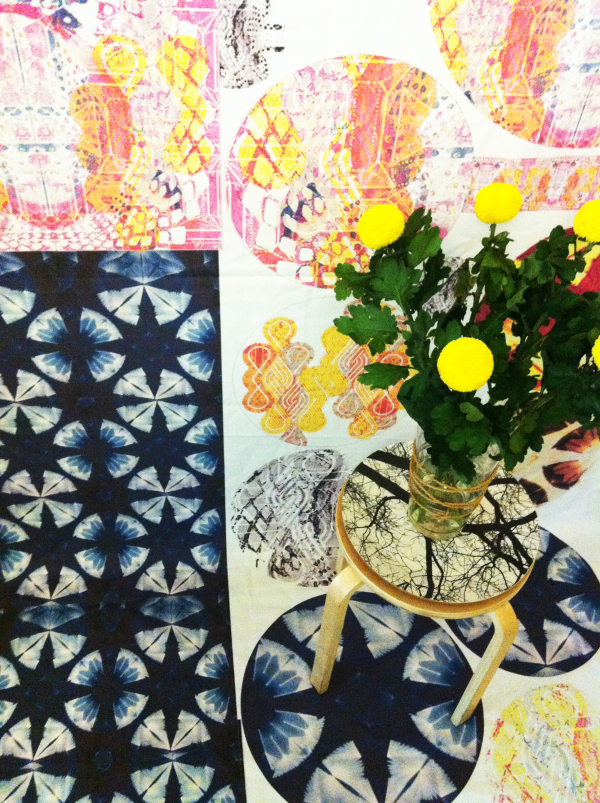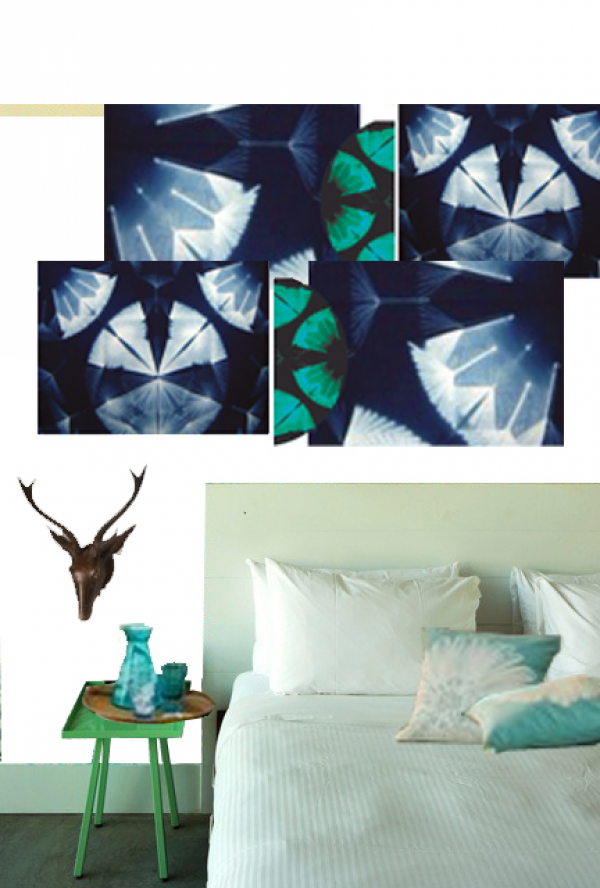


Image Credit : Photographs By Richelle Doney of etch by design studio

Project Overview
Mid 2012 saw etch by design studio create a contemporary range of textiles to stimulate a revived interest in pattern application that was relevant to our current design culture. The ‘modelis’ collection was inspired by a desire to combine sustainable design with bold, contemporary prints - whether printed, woven, surface pattern or structural and surface material applications.
Inspired by the emerging trend of re-capturing the tactility of traditional, handmade craftsmanship, the designs took inspiration from the far-east and indigo dying. Inspired by an original artwork designed by hand-dying fabrics, the design is fused with the influence of traditional indigo textile patterns. A palette of deep inky indigo, faded blues and bleached out pales, or alternatively strong neon brights with highlights of fuchsia, orange and lime are possible. Creating a luxe –artisian look, the kaleidoscopic motif and ombre colouring embraced the tradition of shibori geometrics for a contemporary textile design and use.
Organisation
Team
Richelle Doney - Creative Director at Etch by Design Studio
Interior designer/stylist and textile designer.
Etch By Design was founded in September 2010 and is a multi-disciplinary design practice with a focus on interior design + styling, furniture, textiles and bespoke object design. An independent creative consultancy, specialising in interior products, that sustain innovation and celebrate creativity, based in Melbourne, Australia.
Project Brief
Interiors are impermanent – they are in a constant state of transformation, in which changes keep their structural and physical organisation shifting from one state to another. The ‘modelis’ range was designed to investigate the spatialisation of pattern design; cutting across the fields of interior architecture, fashion and textile design, and to explore a new pattern language for interior designers to apply as design strategies in projects.
The range is designed for each piece to create varied levels of interest when used, whether at the table, bedroom or on a wall. No matter the scale, finish or application, capturing the current digital print revolution through eye-catching pattern, offering a combination of art and fashion for the surfaces we walk and occupy.
At the heart of the designs is this seasons return to Maximalist prints, embracing a colour-pop design and graphic motif, which stands up as a work of art in its own right.'Modelis' (latvian for pattern) was inspired by the hand-drawn mark – a design that has an artistic freedom and gestural quality rather than the precise repeats typical of digital design. Embraces notions of tessellation, and was inspired by the handicrafts and colours of eastern travel.
Project Need
Providing a product that delivers an on-trend aesthetic to interior surfaces and design. The design of the textile range examines new potentials for ornamentation using digital fabrication.
This textile range was devised from a perception that both interior design and architecture remain somewhat in the hysteresis of modernism in avoiding pattern, decoration and ornamentation. These elements become secondary, added ‘furnishings’ to the built environment, rather than considered and implemented at the design stage. An awareness of the role of pattern in the narrative of interior spaces as being intrinsic rather than applied was required. Thus, the intention was to redeem ornamentation as an aspect of the built environment, recover and revive its potency as a conveyor of meaning and delight, and to explore potentially meaningful sources and symbols for incorporation into the contemporary interior - reinstating the importance and resource of pattern making and ornamentation.
Design Challenge
By fusing contemporary graphic design imagery to communicate the potential of ornamentation in interior spaces, the designs transform the idea of conventional pattern application into a contemporary design collectible, and function to create an experience where pleasure and fashion are linked through use.
As an experienced multi-disciplinary design professional, it was clear that there existed a market for this innovative textile range. The unexpected combinations of bold patterns and colours intend to look at textile pattern design in a new way, with multiple applications. We experience our surroundings via our senses. Besides form, the haptic characteristics of materials are becoming increasingly important. In addition, our senses work together with our brains, and our powers of association determine for a great deal our perception of our surroundings.
The designs have the ability to be applied to various material ranges - hard and soft, wallpaper and carpet. Blurring relationships between furniture, textiles and traditional soft furnishings for the contemporary home.
Sustainability
Passionate about creating products that are not mass produced and hand-made; the range is printed locally in a Melbourne print studio on natural-fibre fabrics using water-based, non-toxic and solvent free pigment inks to reduce the impact on the environment.
The studios approach to sustainability is about being able to design and produce our products locally, tailoring designs to meet client needs and bespoke commissions. We currently also utilise all excess remnants from print to make other one-off soft furnishings/homewares.
Textile + Surface Design - Interior
This award recognises printed, knitted, woven, surface pattern and illustration for cloth, fabric or structural material and surface design applications. Consideration given to the technical aspects of production, visual aesthetics, and relationship to end product and use.
More Details

